Class Modifications - 156 Super-Sprinter |
Since first entering service in 1988, the class has received numerous modifications that have come from special operating requirements, experience in traffic and improved safety standards.
Changes to the passenger accommodation are featured on the Interior Layout page.

|
The first significant modification, which units from 156.443 had fitted from new, was provision of low profile antenna and wiring for cab to shore radio. Units for use on the RETB signalled West Highland and North Highland lines had radios fitted at Haymarket and Inverness depots prior to entering service. | |
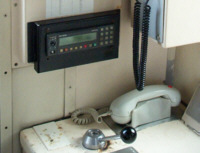
| During 1991 the other units were fitted with VHF band III radios for BR's National Radio Network, and for use on other RETB signalled routes. Units 156.401-442 had antenna fitted at this time. The picture left shows the Philips / Simoco FM1000 series console and hand set on the left hand side of the cab. |
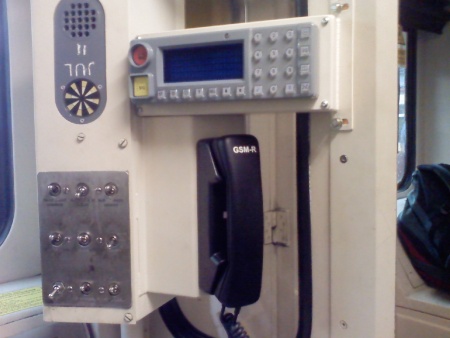
| From November 2006, units in the SPT fleet have been fitted with GSM-R radios. The panel containing the AWS indicator and switches has been modified to fit the extra radio equipment in the cab. The East Kilbride line is to be one of the pilot sites for testing of this new radio system during 2007. Some units appeared without the handsets and control units in place. |
Another early modification was the fitting of deflectors on the cab ends, below the coupling.
The units based at Inverness for the North Highlands and those at Haymarket for West Highland Line duties received these before entering passenger service in early 1989.
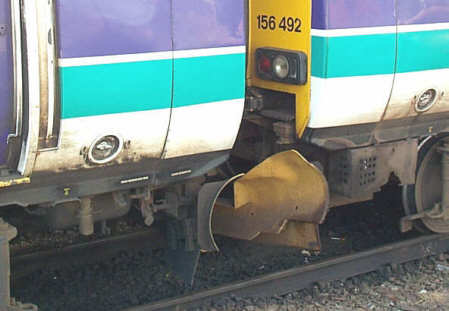
| The deflectors fitted to these Highlands based units were additionally modified to have 2 extra blades mounted on the back of the main fitting, closer to the running rails. This allows the deflector to function more effectively as a snowplough; the design specification was to cope with up to 12 inches of snow. This photo shows the extra snowplough fittings on ScotRail's 156.449 and 156.492 |
Corkerhill units received deflectors from mid 1989. Further south, the Norwich based fleet was equipped from December 1990, and by 1992 the whole class had been fitted.
The main benefit of the deflector is the protection it gives to the train in the event of an obstruction on the line (fallen branches, animals and cars etc.) and in the mid 1990's the other Sprinter classes 150, 153 and 155 were also fitted.
Class 156 vehicles fitted with additional snowplough blades (2005) :
| 52/57436 | 57445 | 52/57446 | 52/57449 | 52/57450 | 57453 |
| 52/57457 | 52/57458 | 52/57474 | 57476 | 52/57477 | 52/57478 |
| 52/57492 | 57496 | 57499 | 57503 | 52/57506 | 52507 |
When the class took over duties on the West Highland line in 1989 the flange squeal on tight curves caused a lot of discomfort to those on-board. This was solved late in the year by gluing an aluminium disc, about 5mm thick, to the web of the wheels. All wheelsets are now fitted in this way.
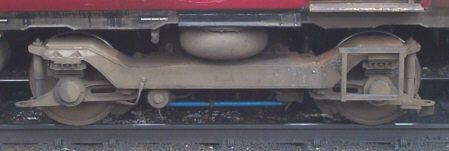 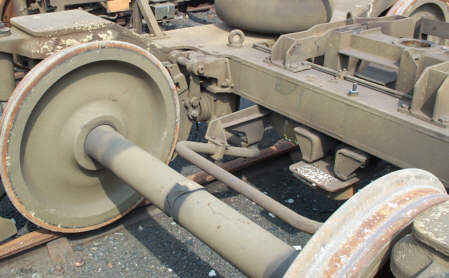
|
A problem that came to light in 1990 was that the new generation DMUs were not always activating track circuits, the train detection part of the signalling system. This was due to the smooth running of these light-weight trains allowing an insulating oxide film to form between the wheels and rail. This problem was most acute on the disc-braked class 158 units which were about to enter service, and led to the fitting of Track Circuit Actuators (TCA) to all modern diesel multiple-units. These are loops under the non-powered bogie which induce a current to flow across the axles and through the film on the wheels. Class 156 units were fitted from 1992 onwards. TCA local fault lights are provided in the vestibules behind the driver's positions. |
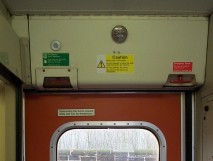
| To give passengers a visual and audible warning that the sliding doors are about to close, 'hustle alarms' were added above the doors from 1993. These flash and warble for about 3 seconds before the doors are closed by the guard. |
Changes to the door interlockings were also made to prevent the brakes from being released unless all doors are proved closed. Previously the Traction Interlock prevented the driver from applying power, but this did not stop a train moving downhill after a station stop.

| In 1990 the Door Key Switches in the cabs were changed from separate key hole and handle, to a more robust key only design. |
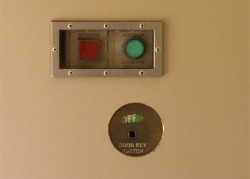
| During the first half of 2006, the nine units operated by 'one' have had the Door Key Switches turned around, so that the guard can operate the doors without first entering the cab. The Door Key Switch is now located under the TCA fault lights in the vestibules behind the driver's position. |
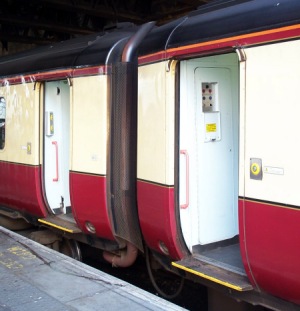
| During the second half of 2005, First ScotRail's units (including those sponsored by Strathclyde PTE) were fitted with additional guard's door control panels in the intermediate vestibules. This is to help the guard conduct revenue protection duties, without needing to return to the rear cab at each station stop to release the doors. The new panel is mounted on the engine control cupboard, next to door 'B'. |
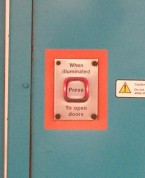 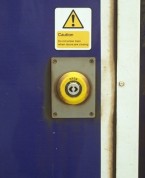 
| The original door buttons (left) were replaced on ScotRail units during 2001 by circular buttons with a raised yellow surround (centre). These are also being fitted to the remaining Angel owned units (Northern Rail) from 2005 onwards. Porterbrook owned units were fitted between 2003-05 with a different style of exterior button, which lacks the raised surround (right). |
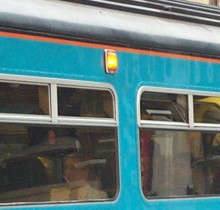 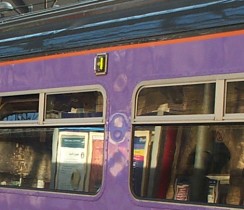
| On Porterbrook owned units the original bodyside hazard lights have been replaced by LED versions. The LED lights last longer than the filament lights, and are more easily seen when looking along the side of a train. The original lamps had an orange cover which could be illuminated by sunlight. |
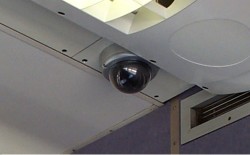 | CCTVScotRail fitted Video Surveillance equipment to a number of it's trains in the late 1990s, including one of the Corkerhill based 156 units. A recent contract has been placed to fit new digital CCTV equipment from Petards Joyce-Loebl to the whole ScotRail 156 fleet. |
 | Fire protection systemTighter environmental legislation meant that the original BCF Halon fire protection system had to be replaced by an ozone-friendly AFFF system. New fire system controls have been fitted in the cabs. The changes were carried out in the mid 1990s |
Class 156 units operated by Central Trains and ScotRail have been modified to allow operation in multiple with class 170 'Turbostar' trains.
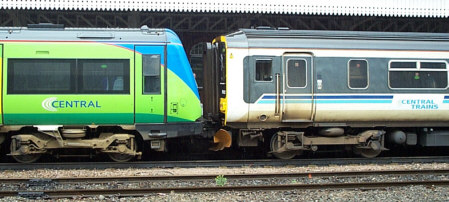 |
Class 170 units have an additional door proving circuit, which before the wiring modification caused the signal buzzer to sound continuously in the driver's cab of a coupled class 156. |
In the cab, DRA buttons have been fitted to prevent the driver from inadvertantly starting the train from a station stop and passing a signal at danger.
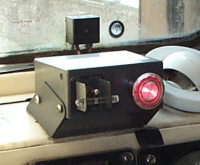 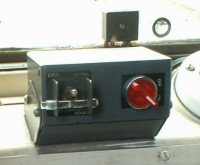 |
The button is manually set and power cannot be applied until the driver has checked the signal aspect and reset the DRA. The majority of class 156s have a push/pull button (left), but the 18 former FNW units were fitted with rotary switches (right). All units had been fitted by the end of 1998 |
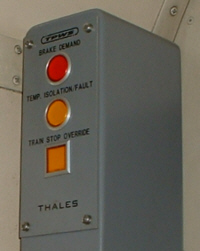
| TPWS equipment had been installed in all units by the end of December 2002. A TPWS electronics box replaced the Automatic Warning System (AWS) control unit, and under the train an aerial is fitted next to the AWS receiver on the leading bogies.In addition to the old AWS functions, which require the driver to acknowledge restrictive signals, TPWS features a timer which monitors the speed of the train approaching danger signals and bufferstops, applying the brake if necessary. It can also stop a train which passes a signal at danger. The existing AWS alarm and 'sunflower' display are retained, but a new control panel is fitted in the top left corner of the cab. |
During Autumn 2002, Central Trains fitted Emergency Sanding Equipment to 19 of its class 156 units. (The 20th, 156.409, was fitted in 2003 following accident repairs). The driver can press a button on his desk to apply the sand if adhesion is lost, and an emergency brake application will also activate the sanders.
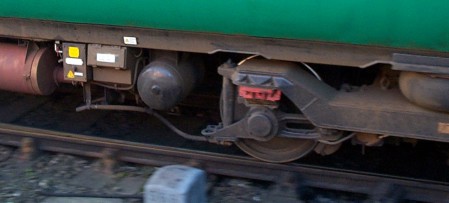 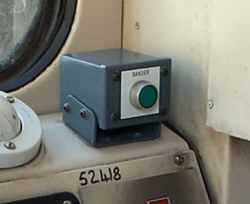
| |
The sand is applied under the leading wheels of the power bogie on the vehicle being driven. | |
The latest mandatory modification is fitting of Data Recorders (OTMR).
Initially two ScotRail units, 156.477/499, were fitted as a trial in 2002. All trains are to be fitted by the end of 2005.
OTMR records the speed of the train, the use of cab controls and status of the safety systems. The data can be downloaded and used for drivers assessment, incident investigations and for fault finding.
The recording equipment is located in the passenger saloon, but a driver's interface is provided in the cab, above the cabside window.
Before starting a journey, the driver must input their ID number and the Reporting ID of the Train (headcode).
 
| Porterbrook owned units are being fitted with OTMR from Arrowvale Electronics (pictured left). The ScotRail and ATN units owned by Angel Trains are being fitted with the Q-Tron Datacord 6100 (right). |
The 28 units sponsored by Strathclyde PTE have had an electronic Passenger Information System fitted.
The first unit to be equiped was 156437, in December 2003, and all 28 had been done by the end of 2005.
Using positional information from GPS, automatic anouncements are made before and after station stops. Calling points of the service are shown on internal displays.
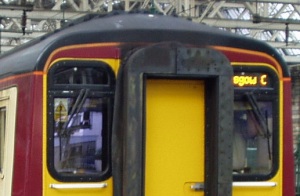
| The destination blind is replaced by a scrolling LED dot-matrix display. The small white dot on the roof above the gangway connection is a GPS aerial. Inside the cab is a touch-screen control panel, which the driver uses to set up the system before the start of each journey. |
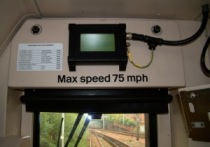 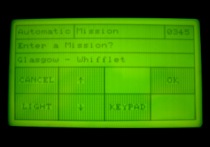 | Each route/stopping pattern has a 4-digit 'mission' number. For example Glasgow - Whifflet is 0345, and Whifflet - Glasgow is 0344.
|
To provide information on the number of passengers travelling on its services, Strathclyde PTE has paid for AEA Technology's Passenger Load Determination system (PLD) to be fitted to some of its trains.
An on-train computer system monitors the pressure in the vehicle's air-suspension and uses this to determine the number of people who left or joined the train at the last station and the number now on board. Combining this with positional information from GPS results in an accurate daily record of the number of passengers carried on each train.
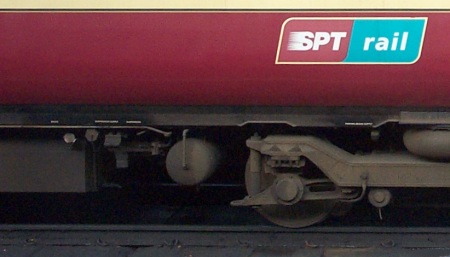
| PLD fitted 156s can be identified by the pipework connected to the air-suspension surge reservoirs next to each bogie. The first to be equiped was 156.506 in May 2004, with eleven more done by the end of 2005. The PLD units fitted are:
|
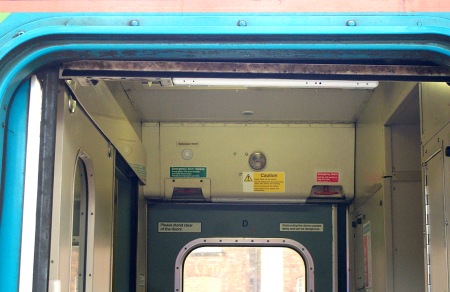
| Northern Rail have adopted a different approach. They have fitted some of their units with Automatic Passenger Counting equipment (APC) supplied by Canadian company Infodev. This uses sensors mounted in the top of the doorways to count passengers boarding and alighting. |
From late 2004, some Central Trains 156s have been fitted with replacement light cluster units, featuring High Intensity Discharge (HID) headlights, also know as Xenon lights, which give up to 3.5 times more light than the previous Tungsten Halogen headlights.
The first set to be fitted was white 156402, before its transfer to Norwich.
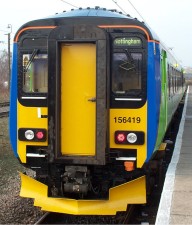 
| In addition to the HID headlights, the marker lights and tail lights are now combined in the same lens by using LEDs. The original arangement had separate oblong marker lights, positioned at the outer ends of the light cluster. |
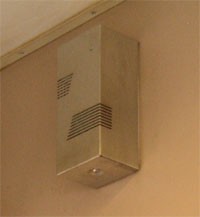
| Air FreshenerCentral Trains have fitted air fresheners to its fleet, including the class 156s during 2005. These battery powered units dispense a natural deodourising dry vapour using a pulsing fan and built in timer. |